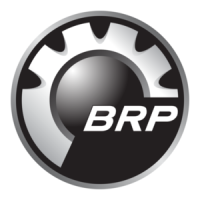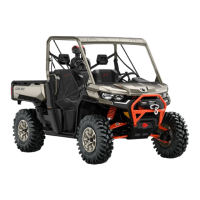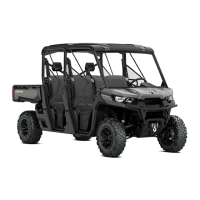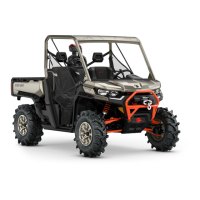Do you have a question about the BRP Can-Am Defender XT HD9 and is the answer not in the manual?
Learn how to reduce the risk of accident by reading the operator's guide and safety labels before operating the vehicle.
Explains the types of safety messages, their appearance, and how they are used in the guide.
Guide prepared to acquaint owner/operator with vehicle controls, maintenance, and safe operating instructions.
Provides essential safety advice regarding carbon monoxide, gasoline hazards, and hot parts.
Details owner and operator responsibilities for safe operation, including qualifications and vehicle checks.
Outlines the critical pre-ride checks to ensure the vehicle is in safe operating condition before each ride.
Covers essential steps before riding, including pre-ride inspection and appropriate riding gear.
Provides guidance on preventing rollovers, tipovers, and collisions through safe driving practices.
Offers advice on practice exercises, turning, braking, and general driving techniques for safe operation.
Highlights key safety labels affixed to the vehicle for user information and safety.
Details safety labels applicable to vehicles outside North America for user information and safety.
Location and function of the steering wheel, including safety advice for rough conditions.
Details the accelerator pedal's location and function in controlling engine speed.
Explains the location and function of the brake pedal for slowing or stopping the vehicle.
Describes the shift lever's location and function for changing gearbox positions.
Information on ignition switch positions and the D.E.S.S. key system for vehicle operation.
Details the side nets that help keep limbs inside the vehicle and reduce injury risk.
Describes the shoulder guards that help restrain occupants inside the vehicle.
Explains the importance and proper use of 3-point seat belts for occupant safety.
Overview of the multifunction display, its views, and indicators.
Details the functions and operation of the 7.6" digital display and keypad.
Defines conditions considered severe duty that require increased maintenance frequency.
Outlines increased maintenance requirements for vehicles used in deep mud or water.
Instructions for inspecting, cleaning, and replacing the engine air filter.
Guidelines for inspecting and replacing the CVT air filter based on riding conditions.
Details recommended engine oil types and procedures for checking and changing oil.
Instructions for removing and installing the oil filter for both mono and twin cylinder engines.
Information on recommended engine coolant types and procedures for replacing coolant.
Details recommended gearbox oil and procedures for checking and changing oil.
Procedures for removing and installing the drive belt for mono and twin cylinder engines.
Provides detailed technical specifications for the engine, including type, cylinders, valves, and dimensions.
Specifies recommended engine oil types, capacities, and alternatives.
Details gearbox type, capacity, and recommended oil specifications.
Technical specifications for front and rear brakes, including fluid type and capacity.
Details dry weight, weight distribution, cargo box capacity, and total load limits.
Provides common issues and their solutions for CVT belts, engine starting, and performance.
Troubleshooting steps for a slipping CVT belt, potentially due to water ingress.
Diagnoses issues preventing the engine from turning over, related to keys, shift lever, or battery.
Troubleshooting steps for when the engine cranks but does not start, covering fuel and ignition.
Addresses issues causing reduced acceleration or power, such as seat belts or air filters.
Troubleshooting steps for engine overheating, including coolant level and fan operation.
Learn how to reduce the risk of accident by reading the operator's guide and safety labels before operating the vehicle.
Explains the types of safety messages, their appearance, and how they are used in the guide.
Guide prepared to acquaint owner/operator with vehicle controls, maintenance, and safe operating instructions.
Provides essential safety advice regarding carbon monoxide, gasoline hazards, and hot parts.
Details owner and operator responsibilities for safe operation, including qualifications and vehicle checks.
Outlines the critical pre-ride checks to ensure the vehicle is in safe operating condition before each ride.
Covers essential steps before riding, including pre-ride inspection and appropriate riding gear.
Provides guidance on preventing rollovers, tipovers, and collisions through safe driving practices.
Offers advice on practice exercises, turning, braking, and general driving techniques for safe operation.
Highlights key safety labels affixed to the vehicle for user information and safety.
Details safety labels applicable to vehicles outside North America for user information and safety.
Location and function of the steering wheel, including safety advice for rough conditions.
Details the accelerator pedal's location and function in controlling engine speed.
Explains the location and function of the brake pedal for slowing or stopping the vehicle.
Describes the shift lever's location and function for changing gearbox positions.
Information on ignition switch positions and the D.E.S.S. key system for vehicle operation.
Details the side nets that help keep limbs inside the vehicle and reduce injury risk.
Describes the shoulder guards that help restrain occupants inside the vehicle.
Explains the importance and proper use of 3-point seat belts for occupant safety.
Overview of the multifunction display, its views, and indicators.
Details the functions and operation of the 7.6" digital display and keypad.
Defines conditions considered severe duty that require increased maintenance frequency.
Outlines increased maintenance requirements for vehicles used in deep mud or water.
Instructions for inspecting, cleaning, and replacing the engine air filter.
Guidelines for inspecting and replacing the CVT air filter based on riding conditions.
Details recommended engine oil types and procedures for checking and changing oil.
Instructions for removing and installing the oil filter for both mono and twin cylinder engines.
Information on recommended engine coolant types and procedures for replacing coolant.
Details recommended gearbox oil and procedures for checking and changing oil.
Procedures for removing and installing the drive belt for mono and twin cylinder engines.
Provides detailed technical specifications for the engine, including type, cylinders, valves, and dimensions.
Specifies recommended engine oil types, capacities, and alternatives.
Details gearbox type, capacity, and recommended oil specifications.
Technical specifications for front and rear brakes, including fluid type and capacity.
Details dry weight, weight distribution, cargo box capacity, and total load limits.
Provides common issues and their solutions for CVT belts, engine starting, and performance.
Troubleshooting steps for a slipping CVT belt, potentially due to water ingress.
Diagnoses issues preventing the engine from turning over, related to keys, shift lever, or battery.
Troubleshooting steps for when the engine cranks but does not start, covering fuel and ignition.
Addresses issues causing reduced acceleration or power, such as seat belts or air filters.
Troubleshooting steps for engine overheating, including coolant level and fan operation.
| Brand | BRP |
|---|---|
| Model | Can-Am Defender XT HD9 |
| Category | Offroad Vehicle |
| Language | English |












